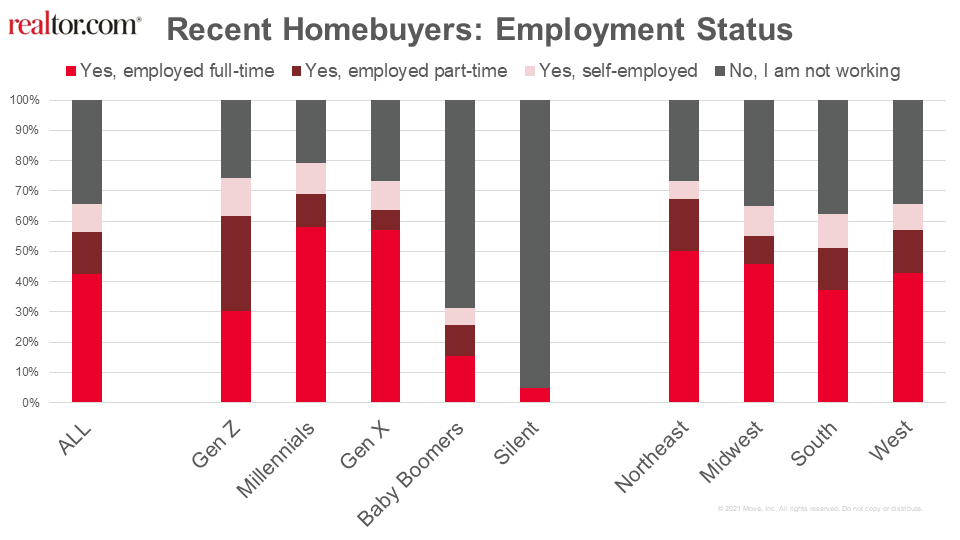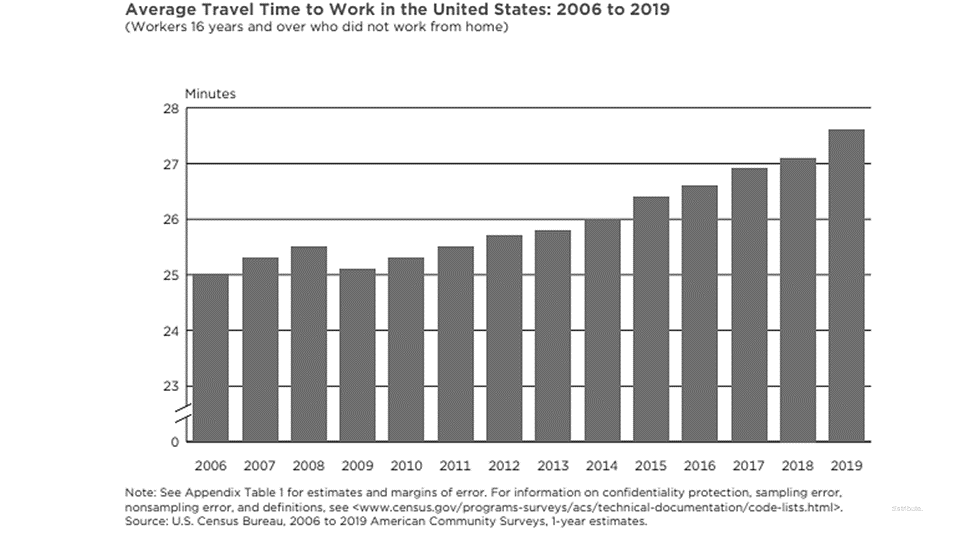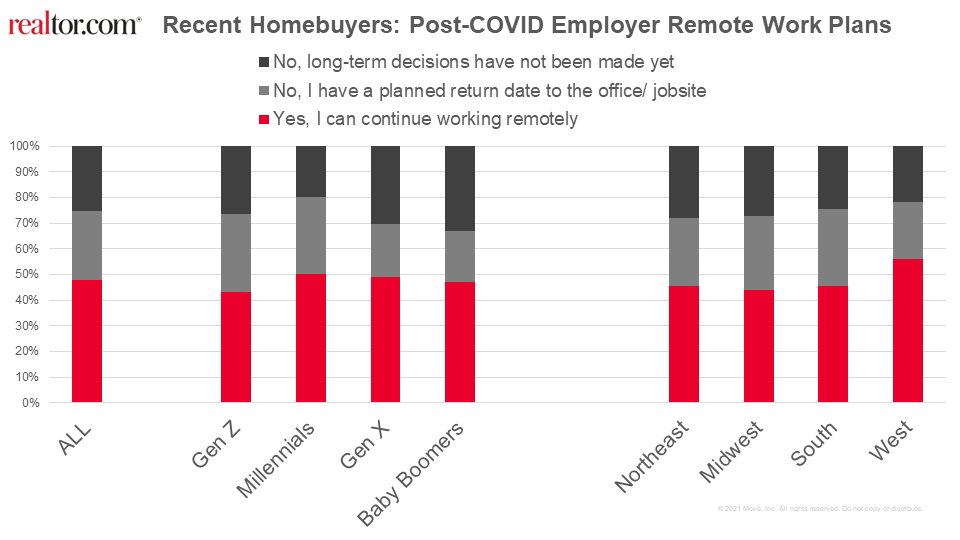- Majority of recent homebuyers prefer remote work
- About four-in-ten recent homebuyers work remotely
- Commute times reach new records as homebuyers search for affordability
- Younger homebuyers are more willing to embrace longer commutes
- Close to half of recent homebuyers report companies embracing remote work
- Almost half of recent homebuyers working remotely want hybrid employment post-COVID
The past year has fundamentally altered many aspects of our daily lives, along with a host of long-held assumptions or beliefs about work, quality of life, and what “normal” should look like. The need for social distancing turned remote work into an overnight reality and success, 25 years in the making. The promise made when the internet came on the scene in the mid-1990s—someday, we’ll be able to work from anywhere—was fulfilled in 2020. While companies and employees embraced it by necessity, the reality of working remotely proved itself viable because the technological platforms and solutions had already been available. Just as importantly, in light of the massive wave of layoffs in April 2020, without the success of remote work, the unemployment crisis would have been even more dramatic. In many ways, technology and peoples’ ability to conduct business in a decentralized fashion saved the economy from additional pain, and is priming activity for a faster rebound.
For real estate markets, millions of workers’ new-found ability to work from their homes changed how they view housing, what they need from homes, and where they want to spend their money. We saw location, size, and home type preferences change in significant ways this year. And Americans voted with their money by buying homes in very different locations than they had over the prior decade. After a decade of flocking into high-density urban downtowns, people pivoted toward larger homes, bigger yards, greener neighborhoods, and affordable communities. The pandemic brought quality of life to the forefront, elevating the profile of suburban markets, along with mid- and small-sized cities across the country.
The new Wall Street Journal/realtor.com Emerging Housing Markets Index shines a spotlight on these very communities, which offer desirable locations and outdoors amenities, along with solid and diversified local economies, population diversity and entrepreneurship, and more affordable houses. Furthermore, these markets indicate that for many Americans, the forward-looking employment landscape is a hybrid one, which involves some time in an office, along with remote work capabilities. This expectation was clear in homebuyers’ willingness to look much farther away from downtown office centers, drawing a wider, 2-hour or longer potential commute circle.
Within this context, we partnered with HarrisX to survey recent homebuyers across the country, and find how they view their house purchases in light of the country’s move toward a new normal. The results show that the benefits of remote work have already been incorporated into housing decisions. In addition, most recent homebuyers prefer working remotely, and likely do not miss long, expensive and unpleasant commutes.
Younger Workers Drive Real Estate Markets
When we ran the survey this spring, a majority of survey respondents were employed, with 43% working full-time. Underscoring demographic trends, the highest share of those employed full-time were Gen X and millennials. The data point to the strong influence that millennials and Gen X buyers have on this year’s markets, especially as so many young professionals are transitioning into their mature stage of life, forming families and having children. These changes are also prompting a shift toward larger homes and neighborhoods with good schools.
About Four-in-Ten Recent Homeowners Work Remotely
Of those who are employed, close to four-in-ten worked remotely as a result of the COVID pandemic. Another 20% worked remotely since before the pandemic, a sign of shifting trends in a technology-enabled employment format. Across generations, Gen Z homebuyers reported the largest share of remote workers, followed by millennials and Gen X. Regionally, the share of remote workers was highest in the Northeast and West, likely mirroring the concentration of technology and information services companies in coastal metro areas.
Majority of Recent Homebuyers Prefer Remote Work
In the wake of a year when daily meetings, conversations, interviews and even conferences were conducted virtually, the lack of hassle-filled commutes, clothing and dry cleaning expenses, and reclaimed personal time, have changed Americans’ preferences. We asked a national sample of consumers in the summer of 2020, after the lockdowns ended, where they preferred working, and 52% said they preferred remote locations over offices.
The recent, spring 2021 survey showed an even stronger shift toward remote work, with 62% of recent homebuyers indicating they favor it. Interestingly, the share of those who prefer remote work was the highest for Gen Z respondents, followed by millennials and Gen X. As the largest cohort moves into the child-rearing stage of life, work flexibility seems to take a much more prominent role in decisions. Regionally, a larger share of homeowners in Western cities indicated a preference for remote work arrangements.
Younger Homebuyers Are More Willing to Embrace Longer Commutes
For a little over half of recent homebuyers, there was no change in willingness to commute farther for work. Of the rest, 16% indicated they would were more willing to commute farther, and 31% pointed to less willingness for a longer commute. Interestingly, younger homebuyers were more willing to buy homes farther away from their work locations, with 27% of Gen Z and 22% of millennials picking the option, compared with 13% of Gen Xers and only 3% of Baby Boomers. Geographically, the West region had the highest share of respondents who were more willing to exchange a desirable home for a longer commute.
Commute Times Reach New Records as Homebuyers Search for Affordability
Commute times were an integral part of most Americans’ decision process when considering a job or a home location. And the combination of population and urban growth over the decades translated into longer time spent traveling to and from work. In fact, a recent report from the U.S. Census Bureau illustrated the significant changes. The data show that average one-way commute rose to a record high in 2019, reaching 27.6 minutes. In comparison, the average one-way commute in 2006 was 25 minutes, translating into a 10% increase over the 14-year span. Just as importantly, according to the research, “In 2006, 14.8% of commuters reported travel times of less than 10 minutes; this group declined to 11.9% by 2019. Conversely, the percentage of workers reporting commutes of 60 minutes or longer increased from 7.9% in 2006 to 9.8% in 2019.” And workers in urban areas depending on public transportation experienced the longest average times, with bus commuters spending an average of 46.6 minutes going to their place of employment.
In light of these national trends, realtor.com’s survey data show that a noticeable share of recent homebuyers traded longer commutes in exchange for desirable homes and more affordable communities. Close to 40% of homebuyers reported one-way commute times from their new homes to workplaces that were over 30 minutes long. Generational cohorts illustrate how a much larger share of younger professionals are making the tradeoff, with 45% of both Gen Z and millennial respondents saying their one-way commutes were over 30 minutes. In comparison, only 29% of Gen Xers and 21% of Baby Boomers reported one-way commutes longer than 30 minutes. Regionally, buyers in the Northeast and West had larger shares of 30-minute or longer commutes, at 53% and 40%, respectively.
In addition, almost one-in-five recent homebuyers indicated that their one-way commute was over 60 minutes. This figure stands in sharp contrast with the US Census Bureau’s findings from 2019, showing that about 10% of Americans spent over an hour one-way going to work.
The search for affordability is clearly being felt differently across demographic cohorts, with younger buyers more likely to look for homes farther away. Close to a third of Gen Z and 20% of millennial recent homeowners reported one-way commutes longer than an hour. In comparison, only 11% of Baby Boomers and 8% of Gen Xers indicated that they would spend over two hours of their days traveling to and from work. The shares of those with over one hour one-way commutes were highest in the Northeast and West.
Close to Half of Recent Homebuyers Report Companies Embracing Remote Work
Many companies are recognizing that high-density, expensive cities have become unattainable for many young professionals. In an effort to meet talent in more affordable metros, companies have been opening satellite campuses and second headquarters. From Amazon’s much-publicized search a couple of year ago which ended with Arlington, VA as a choice, to Apple’s recent announcement that it would build its East Coast HQ in the Raleigh-Durham area, employers are recognizing that flexibility is crucial in today’s employment landscape.
The pandemic further shifted these trends, with many companies choosing to go fully remote. The realtor.com survey found that 48% of recent homeowners who worked remotely reported that their employers gave them the option to continue to work remotely after COVID. For 27% of homeowners, their employers have already announced a planned return to an office or job site. And a quarter of respondents indicated that no long-term decisions have been made.
Looking at generational cohorts, recent millennial homebuyers who are remote showed the highest share of flexible employers, at 50%. Recent Gen X homebuyers had the second-highest share of respondents whose employers indicated they could continue working remotely (49%), followed by Baby Boomers (47%), and Gen Zers (43%). Geographically, the West region had the highest share of respondents who reported being able to continue working remotely (56%), followed by the South (46%), Northeast (45%) and Midwest (44%).
Almost Half of Recent Homebuyers Working Remotely Want Hybrid Employment post-COVID
An important question for many homeowners and companies this year will revolve around the road forward, as we collectively weigh the steps to take toward returning to a new normal. As companies consider their real estate footprint needs, it will be worthwhile to consider that a majority of Americans prefer working remotely to some extent going forward. Blending part-time office collaboration with remote work into a hybrid model may be an ideal option, which could result in smaller overhead and happier employees.
For workers who have purchased a home this past year, this hybrid approach seems to be the favored path. Almost half of recent homeowners whose employers may decide to ask employees to return to an office or job site plan to arrange a schedule that allows for some in-office combined with some remote work. Surprisingly however, almost one-in-four plan to find a new job, not willing to compromise on the benefits of the new environment. Less than 10% would sell their current house, and only a third would resume going to the office with no other changes.
The share of respondents planning to arrange a hybrid work schedule was highest for Gen Z (57%), followed by millennials (50%). The younger cohorts also showed the highest comparative shares of people willing to find a new job if their employer showed lack of flexibility—25% for Gen Z and 23% for millennials. Conversely, Baby Boomers were more likely to return to the office without other changes.
Geographically, the Midwest had the highest share of respondents considering new employment as an alternative to full-time office presence (34%), followed by the West (34%). The South had the largest share of respondents looking for a hybrid office-remote model (56%), followed by the Northeast (54%).
Implications for Employers and Housing
Throughout the last year we have seen homebuyers across the country, empowered by the new found ability to work remotely, moving farther and farther from crowded urban downtowns in search of more space, higher quality of life, and a lower cost of living. The millennial generation is coming into its own of home buying age, and contrary to a decade’s worth of typecasting as the “renter generation,” it is broadly embracing homeownership.
Our survey data shows that people are really enjoying their new communities and larger homes, and aren’t willing to give them up anytime soon. Looking forward, if companies return to more conservative policies on working from home, we could see an influx of new homeowners in the job market. For companies willing to stay more flexible with either hybrid or entirely remote opportunities, there is a large cohort of young professionals with growing families who value homeownership and affordability, and welcome the benefits of a technologically-enhanced employment landscape.
Furthermore, the current trends are democratizing the economic wealth and benefits which have accumulated to select coastal markets, bringing residents and higher wages to mid-sized communities across the country. In turn, these communities are experiencing economic and population revitalization, moving in a virtuous cycle of growth.
While housing markets across the country are currently wrestling with an imbalance between strong demand and inadequate supply, the upward price pressures are likely to abate later this year, as a significant wave of sellers is expected to bring homes to market. For cities experiencing this influx, a thoughtful and strategic approach to zoning, new construction and development is key to ensure a sustainable long-term trajectory.
Methodology: Realtor.com® commissioned HarrisX to conduct a national survey of consumers. This survey was conducted online within the United States from March 26 – April 7, 2021. The survey was conducted among 3,998 adults by HarrisX. The sampling margin of error of this poll is plus or minus 1.6 percentage points. The results reflect a nationally representative sample of adults. Results were weighted for age, gender, region, race/ethnicity, and income where necessary to align them with their actual proportions in the population. In addition to the general population, oversamples were collected for new homeowners. The oversamples were weighted to align with the original sample. There are 1,000 new owners who bought a home in the last 12 months with a margin of error of plus or minus 3.1 percentage points.
from WordPress https://ift.tt/33HbU9l
via IFTTT









0 Comments